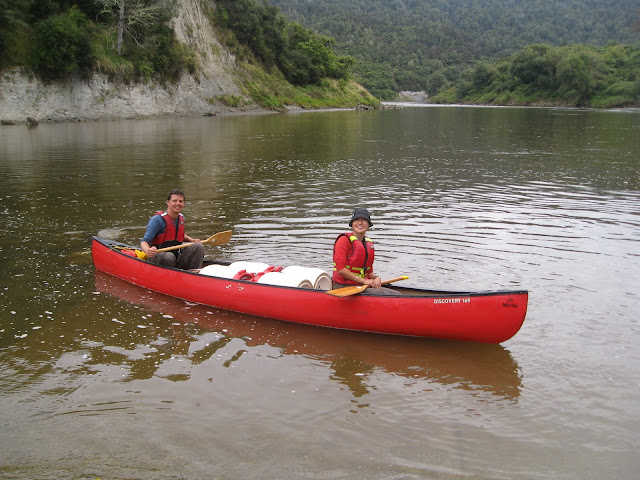Our last “great walk” was spent sitting on our backsides, paddling down a river. It was certainly a nice change for us and we enjoyed not carrying a pack. The great walk section of the river from Taumarunui to Pipiriki takes five days, but there are also options for one, two, three and four day trips on that section of the river. The trip can also be extended right down to Wanganui by adding another two days from Pipiriki. There are a number of rental companies who will rent out Canadian Canoes or kayaks for use and provide transport to and from the river. We chose to do the 145km, five day paddle in a Canadian Canoe rented from Blazing Paddles because the canoe gave us plenty of room for food and drinks.
 On our first day we paddled from Cherry Grove in Taumarunui to the Ohinepane Campsite. It was strange paddling on a brown river, but the surroundings were beautiful. We spent the second day journeying to the Mangapapa Campsite. We stopped for lunch in Whakahora where we had a coffee at the blue duck café. The Mangapapa Campsite was high on the bank of the river and provided us with an incredible view up the river valley.
On our first day we paddled from Cherry Grove in Taumarunui to the Ohinepane Campsite. It was strange paddling on a brown river, but the surroundings were beautiful. We spent the second day journeying to the Mangapapa Campsite. We stopped for lunch in Whakahora where we had a coffee at the blue duck café. The Mangapapa Campsite was high on the bank of the river and provided us with an incredible view up the river valley.
The first two days we did not see any other people on the river or at the campsites, but the journey from Whakahora to Pipiriki is the most popular part of the trip so on our third night we finally had company. After a lovely day of paddling we decided to spend the evening at the Mangawaiti Campsite which is high on a rocky bluff above a narrow canyon. It was a steep hike up with our camping gear, but the spot was well worth the walk.


 The highlight of the fourth day of our trip was the walk out to the Bridge to Nowhere. It is a beautiful concrete bridge that was finished in 1936 to service a few farms in the area, but shortly after that the government decided not to maintain the road to the bridge and all the farmers were asked to move out of the area. Local legend has it that somewhere between two and five cars drove across the bridge. Now it is the largest tourist attraction in the Whanganui National Park with tourists taking jet boats up the river and walking in just to get a look at it. After our stop there it was a short paddle down to the Tieke Kainga Marae where we stayed for the night. A marae is a Maori owned group of buildings that are most often used as a meeting place. The one we stayed in also has a DOC hut attached to it and is available for visitor use.
The highlight of the fourth day of our trip was the walk out to the Bridge to Nowhere. It is a beautiful concrete bridge that was finished in 1936 to service a few farms in the area, but shortly after that the government decided not to maintain the road to the bridge and all the farmers were asked to move out of the area. Local legend has it that somewhere between two and five cars drove across the bridge. Now it is the largest tourist attraction in the Whanganui National Park with tourists taking jet boats up the river and walking in just to get a look at it. After our stop there it was a short paddle down to the Tieke Kainga Marae where we stayed for the night. A marae is a Maori owned group of buildings that are most often used as a meeting place. The one we stayed in also has a DOC hut attached to it and is available for visitor use.
Our last day on the river took us through the three larges rapids that we experienced on the trip, Ngaporo, Autapu and Paparoa. Thankfully by this point in the journey we had gotten better at paddling together and managed to keep the canoe upright through all three.
After our journey was over we took a drive on the Forgotten World Highway. It took us through some of the most incredible farming country that we have seen. It was full of steep peaks and deep valleys with almost no visible access. We made a quick stop in the Republic of Whangamomona to get our passports stamped before continuing on to Mt. Taranaki.















